
Map of Southeastern Pennsylvania, showing bounderies of Maryland, Delaware, and New Jersey. (Artwork, Nichole Drgan.)
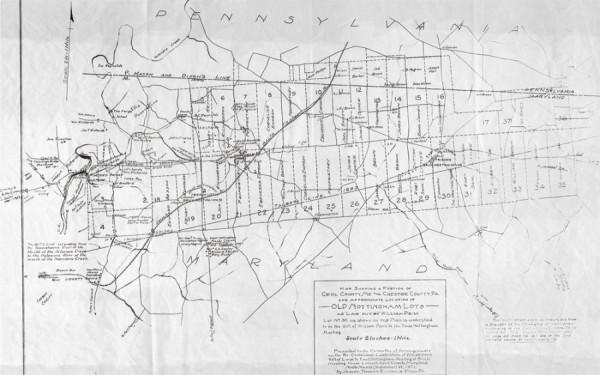
1901 reproduction of “A Draught of the Township of Nottingham according to a Survey made thereof in the third Month AD 1702.” (Courtesy, Chester County Historical Society.)

Spice box, attributed to the shop of Thomas Coulson (1703–1763) and possibly to John Coulson (1737–1812), Nottingham area, Chester County, Pennsylvania, 1740–1750. Walnut and red cedar, sumac, and holly inlay with white oak. H. 19 3/4", W. 16 1/4", D. 11". (Private collection; photo, Laszlo Bodo.)
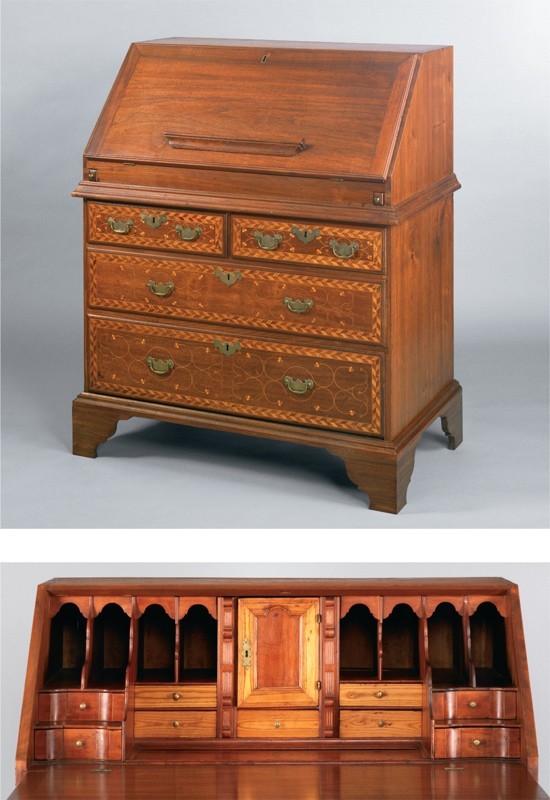
Desk attributed to Hugh Alexander (1724–1777), Nottingham area, Chester County, Pennsylvania, or Cecil County, Maryland, 1745–1760. Walnut and red cedar, maple, holly and sumac inlay, with chestnut, tulip poplar, white cedar. H. 45 3/4", W. 39 1/8", D. 22 1/8". (Courtesy, Winterthur Museum; photo, Laszlo Bodo.) The sides of the case extend down to form supports for the foot faces. This feature occurs on later desks from the Nottingham area (see figs. 36 and 37).
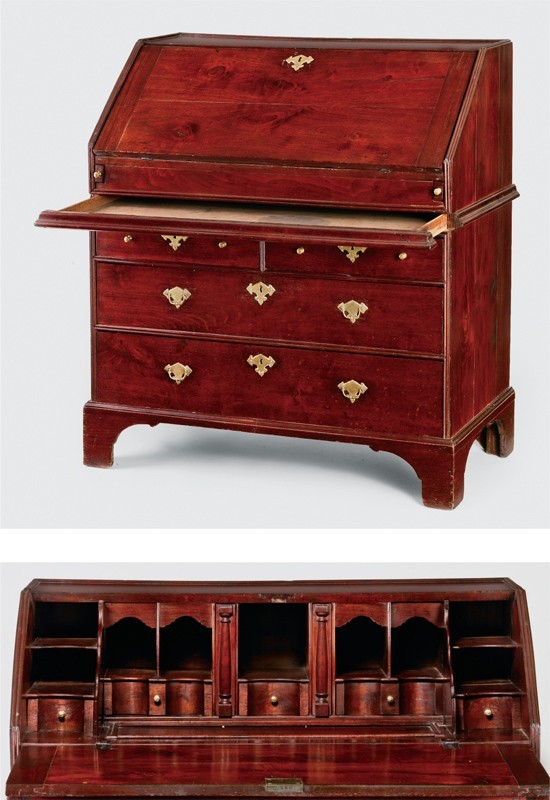
Desk, probably Nottingham area, Chester County, Pennsylvania, or Cecil County, Maryland, 1740–1760. Walnut with tulip poplar. H. 41 3/8", W. 40", D. 20 3/8". (Private collection; photo, Gavin Ashworth.) A unique feature of this desk is the shallow secret drawer concealed by the medial molding above the small upper drawers.

Exterior of the John and George Churchman House, Rising Sun, Cecil County, Maryland, 1745 and 1785. (Photo, Laszlo Bodo.) The three-bay stone addition was added to the west side in 1785.

Detail of the date stone on the Isaac and Mary Haines House, Rising Sun, Cecil County, Maryland, 1774. (Photo, Laszlo Bodo.)

Detail of a built-in cupboard in the Isaac and Mary Haines House, Rising Sun, Cecil County, Maryland, 1774. (Photo, Laszlo Bodo.)
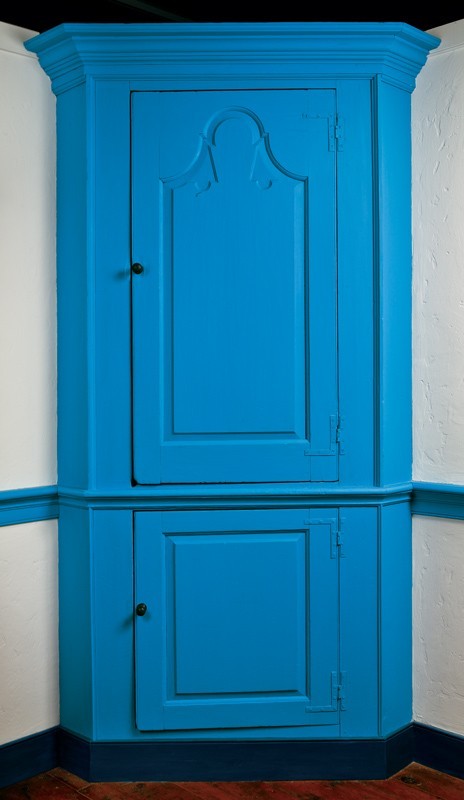
Corner cupboard, Nottingham area, Chester County, Pennsylvania, or Cecil County, Maryland, 1770–1800. (Courtesy, Chester County Historical Society; photo, Gavin Ashworth.)9

Detail of an interior doorway in the Isaac and Mary Haines House, Rising Sun, Cecil County, Maryland, 1774. (Photo, Laszlo Bodo.)
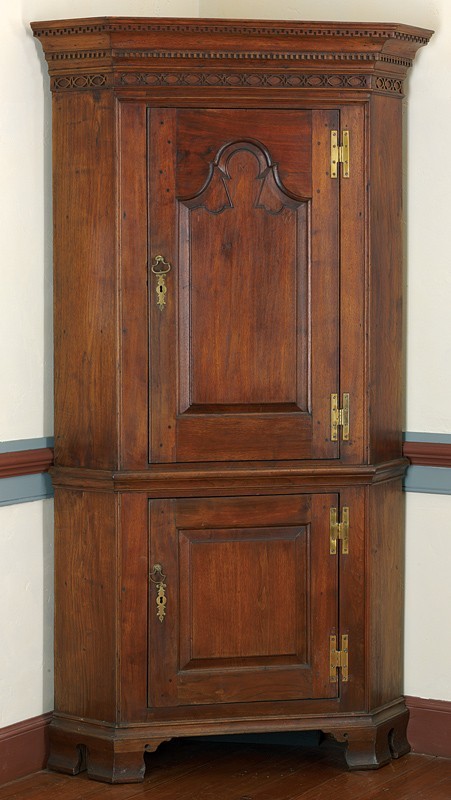
Corner cupboard, Nottingham area, Chester County, Pennsylvania, or Cecil County, Maryland, ca. 1770–1800. Walnut and lightwood inlay. H. 77 3/4", W. 43 1/2", D. 25 1/2". (Courtesy, Baltimore Museum of Art, gift of J. Gilman D'Arcy Paul, BMA 1970.45.3. Photo by Mitro Hood.) Since no early history of ownership survives for this cupboard, the possibility of extrapolating a name from the “IMW” initials on the upper door panel is remote.
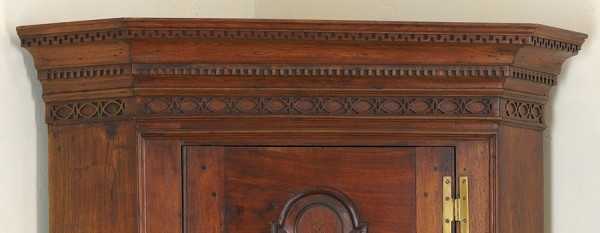
Detail of the cornice of the cupboard illustrated in fig. 11.
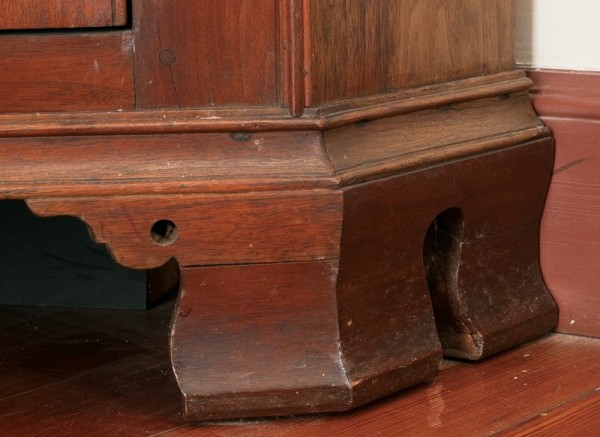
Detail of the right front foot of the cupboard illustrated in fig. 11. With its tall shallow cove and underscale ovolo, the base molding conforms to a common local pattern.

Clothespress, Nottingham area, Chester County, Pennsylvania, or Cecil County, Maryland, 1780–1800. Walnut with tulip poplar and maple. H. 85 5/8", W. 71 1/4", D. 25". (Private collection; photo, Gavin Ashworth.) The cornice of this press has Greek key and drilled dentil elements similar to those on the cupboard illustrated in figs. 11 and 12.
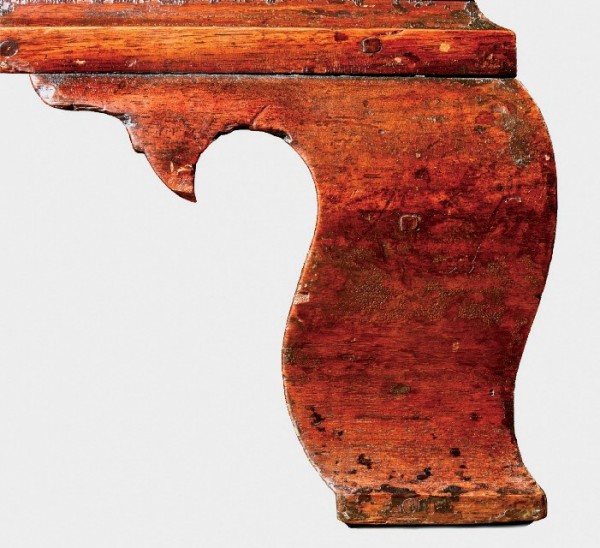
Detail of the right front foot of the clothespress illustrated in fig. 14. (Photo, Gavin Ashworth.)

Tall-case clock with movement by Benjamin Chandlee Jr., Nottingham area, Chester County, Pennsylvania, or Cecil County, Maryland, 1760–1775. Walnut with tulip poplar. H. 107", W. 22 1/2", D. 11 1/2". (Courtesy, Winterthur Museum; photo, Laszlo Bodo.) The carved appliqués on the plinth are rabbeted to overlap the square corners of the base panel, presumably to allow for seasonal shrinkage and expansion. The feet and base molding are restored.

Tall-case clock with movement by Benjamin Chandlee Jr., Nottingham area, Chester County, Pennsylvania, or Cecil County, Maryland, 1760–1775. Walnut with tulip poplar. H. 99", W. 21 3/4", D. 12 1/4". (Courtesy, Chester County Historical Society; photo, Laszlo Bodo.) The clock was photographed in the house of Susanna Brinton of Gap, Lancaster County, Pennsylvania, before 1924. By that date the upper portion of the sarcophagus top had been removed. The short cabriole legs are visible in that image.
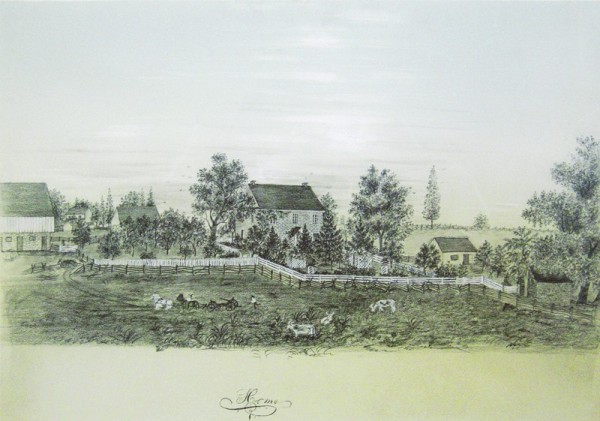
Susanna Brinton, Three Spring Farm, Leacock Township, Lancaster County, Pennsylvania, 1855. Drawing on prepared tinted drawing paper. 9" x 11 3/4". (Courtesy, LancasterHistory,org, Heritage Center Collection (; photo, Leigh Mackow.) Susanna (1833–1927) was Moses Brinton’s great-granddaughter and the last family member to live in his home.
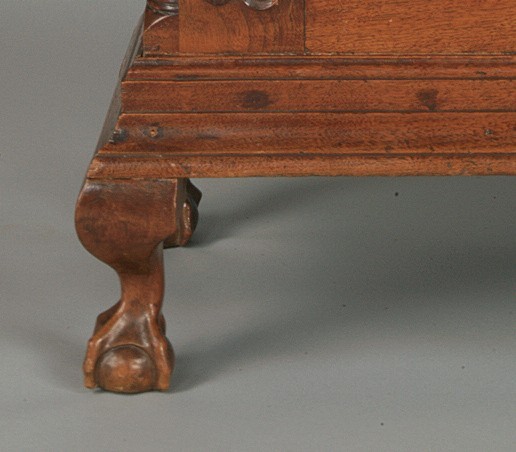
Detail of the left front foot of the clock illustrated in fig. 17. (Photo, Laszlo Bodo.)
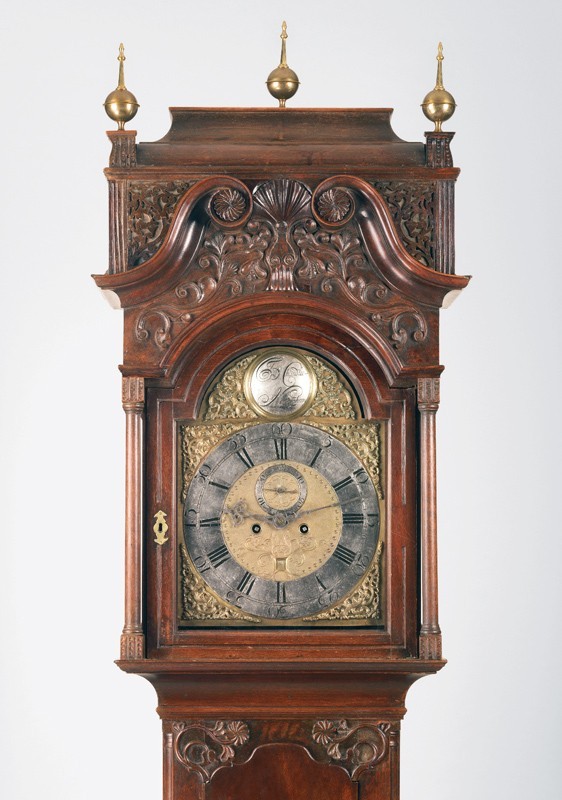
Detail of the hood of the tall-case clock illustrated in fig. 16. (Photo, Laszlo Bodo.)

Detail of a chalk sketch inside the clock illustrated in fig. 16. (Photo, Laszlo Bodo.)

Tall-case clock with movement by Benjamin Chandlee Jr., Nottingham area, Chester County, Pennsylvania, or Cecil County, Maryland, 1750–1775. Walnut with white pine. H. 103 1/4", W. 20 7/8", D. 11 1/8". (Courtesy, Chester County Historical Society; photo, Gavin Ashworth.)
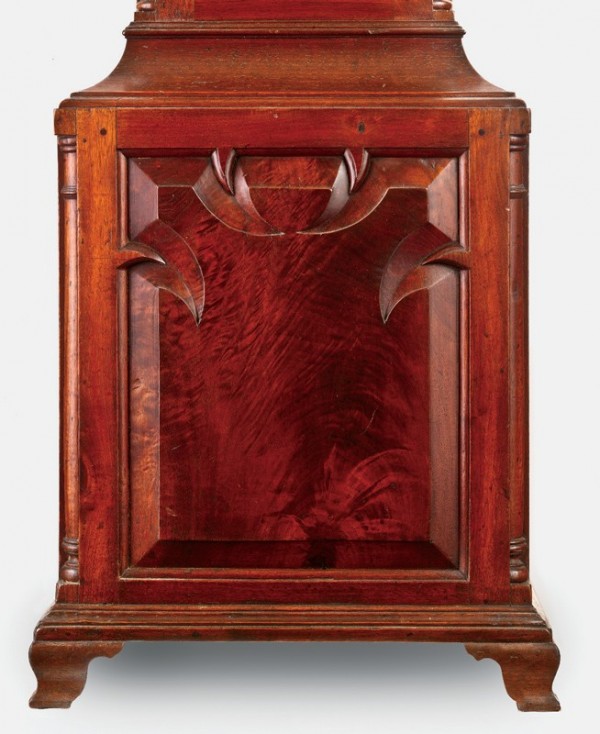
Detail of the plinth panel of the tall-case clock illustrated in fig. 22. (Photo, Gavin Ashworth.)
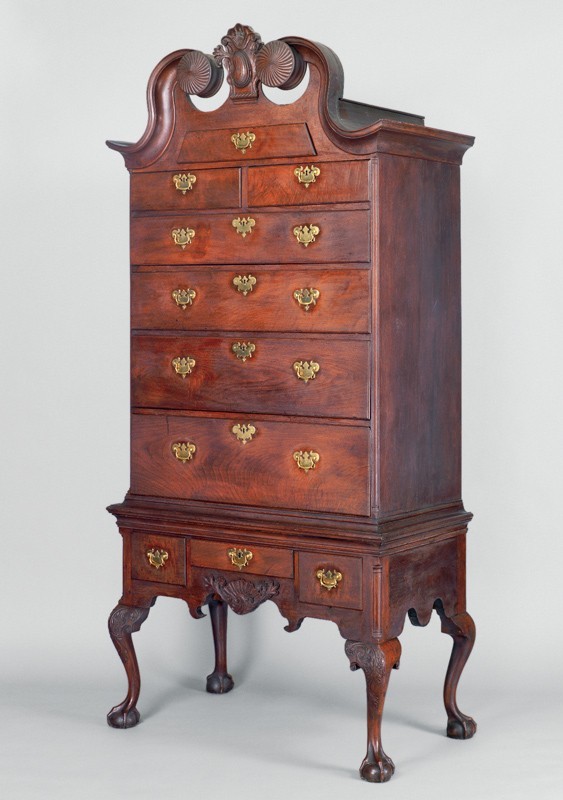
High chest of drawers, Nottingham area, Chester County, Pennsylvania, or Cecil County, Maryland, 1760–1780. Walnut with tulip poplar, hard pine, white cedar. H. 92 3/4", W. 43 1/2", D. 25". (Private collection; photo, Laszlo Bodo.) The pediment scrolls on this chest have a more exaggerated S-curve than those on the example illustrated in fig. 25, but both sets of moldings have oversize volutes with identical appliqués. Similar volutes occur on other furniture from the Nottingham area.

High chest of drawers, Nottingham area, Chester County, Pennsylvania, or Cecil County, Maryland, 1760–1780. Walnut with tulip poplar and oak. H. 95 3/8", W. 43 3/4", D. 25 1/2". (Courtesy, Jeffrey Tillou.) The center ornament is not original.

Detail of the pediment of the high chest of drawers illustrated in fig. 24. (Photo, Laszlo Bodo.)

Detail of a stair bracket in the Isaac and Mary Haines House, Rising Sun, Cecil County, Maryland, 1774. (Photo, Laszlo Bodo.)
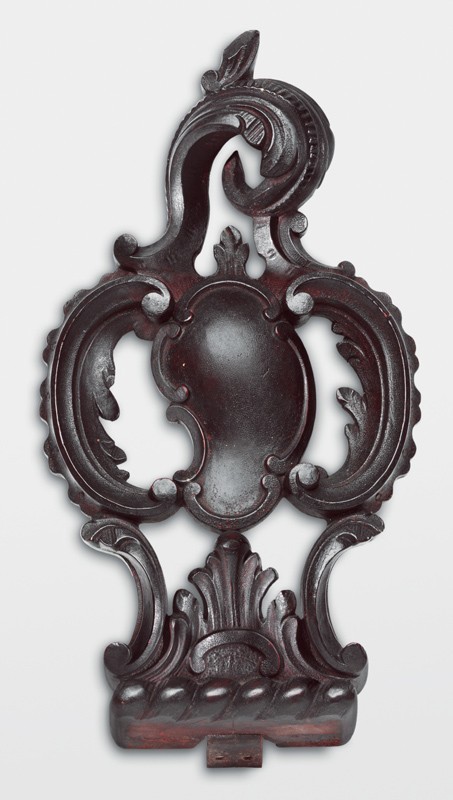
Cartouche attributed to the Garvan high chest carver, Philadelphia, Pennsylvania, ca. 1765. Mahogany. (Courtesy, Philadelphia Museum of Art.)
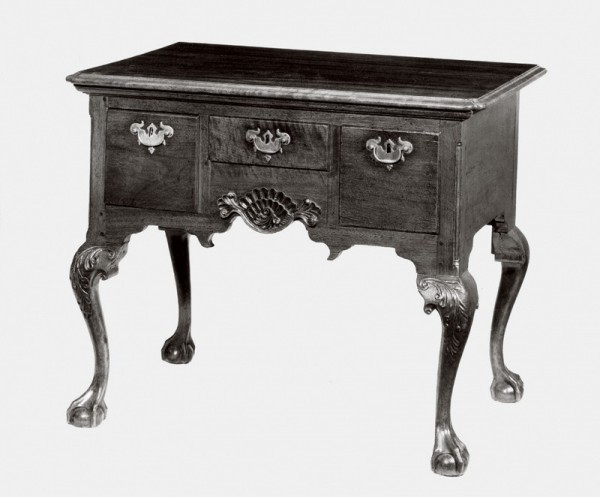
Dressing table, Nottingham area, Chester County, Pennsylvania, or Cecil County, Maryland, 1760–1780. Woods and dimensions not recorded, location unknown. (Courtesy, Philip Bradley Antiques, Inc.)
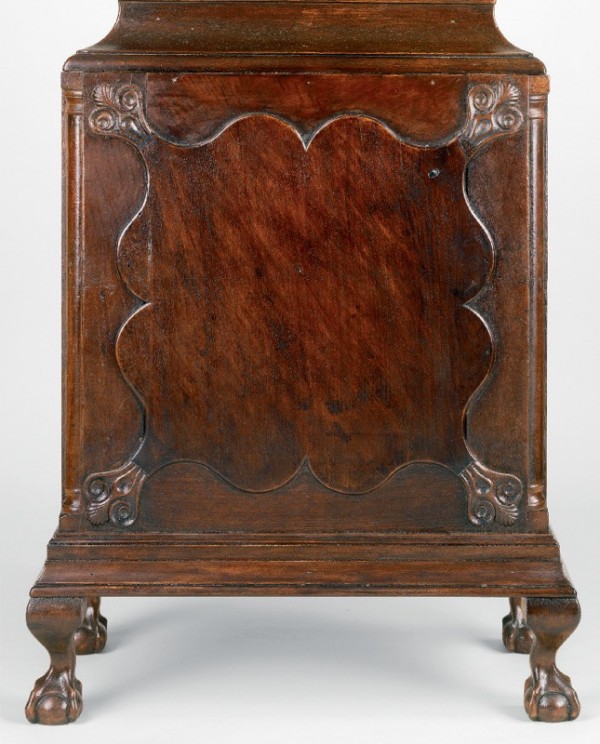
Detail of the plinth of the tall-case clock illustrated in fig. 16. (Photo, Laszlo Bodo.)
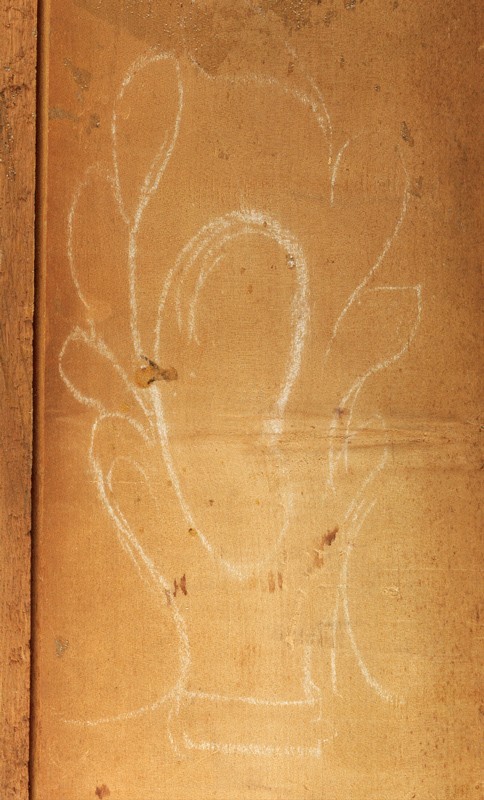
Detail of a chalk sketch in the high chest of drawers illustrated in fig. 24. (Photo, Laszlo Bodo.)
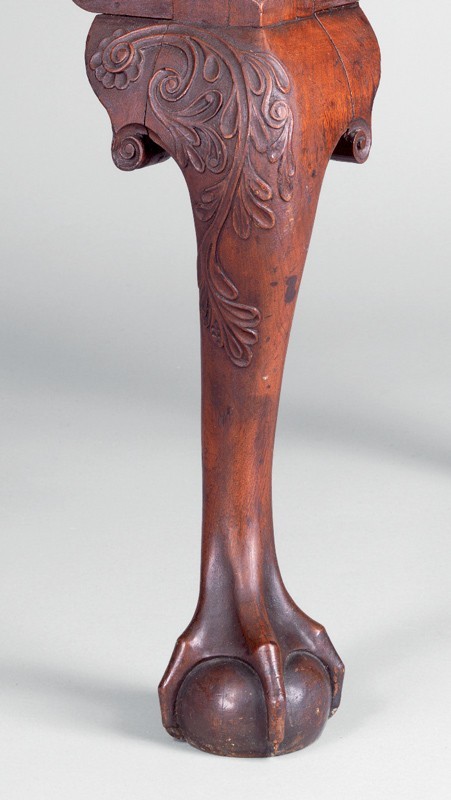
Detail of the leg carving on the high chest of drawers illustrated in fig. 24. (Photo, Laszlo Bodo.)
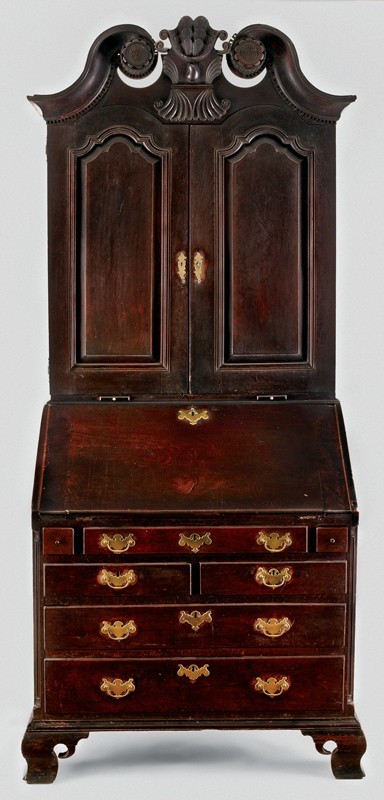
Desk-and-bookcase, Nottingham area, Chester County, Pennsylvania, or Cecil County, Maryland, 1760–1780. Walnut with tulip poplar, white oak, white cedar. H. 96 1/2", W. 42 1/2", D. 24". (Private collection; photo, Gavin Ashworth.)
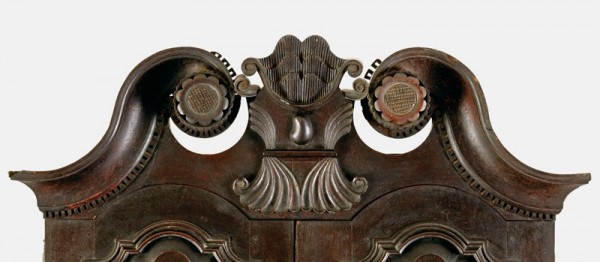
Detail of the pediment of the desk-and-bookcase illustrated in fig. 33. (Photo, Gavin Ashworth.) This rosette pattern occurs on one other case piece from the Nottingham area (see figs. 53, 54).
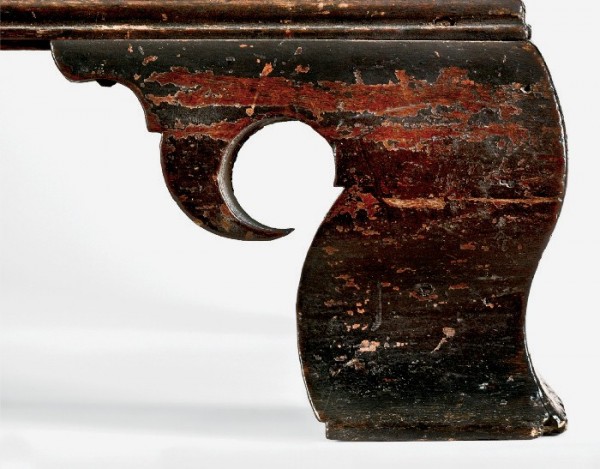
Detail of the right front foot of the desk-and-bookcase illustrated in fig. 33. (Photo, Gavin Ashworth.) The maker drilled out the circular piercing in the feet. Marks from the wing cutter of the bit are visible on the inner edge.
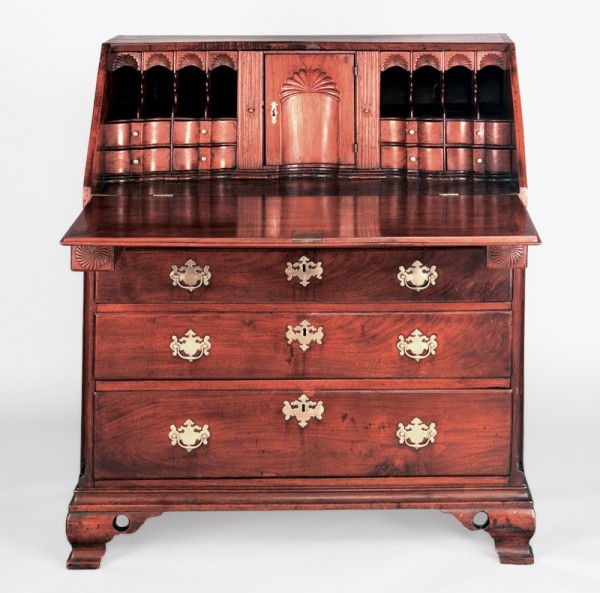
Desk, Nottingham area, Chester County, Pennsylvania, or Cecil County, Maryland, 1770–1800. Walnut with oak, chestnut, and tulip poplar. H. 47", W. 43", D. 22 7/8". (Courtesy, Chester County Historical Society; photo, Laszlo Bodo.) The drawers that support the fallboard have appliqués with convex spiraling like that on the rosettes of the high chests illustrated in figs. 24 and 25 and chest-on-chests shown in figs. 42 and 43.
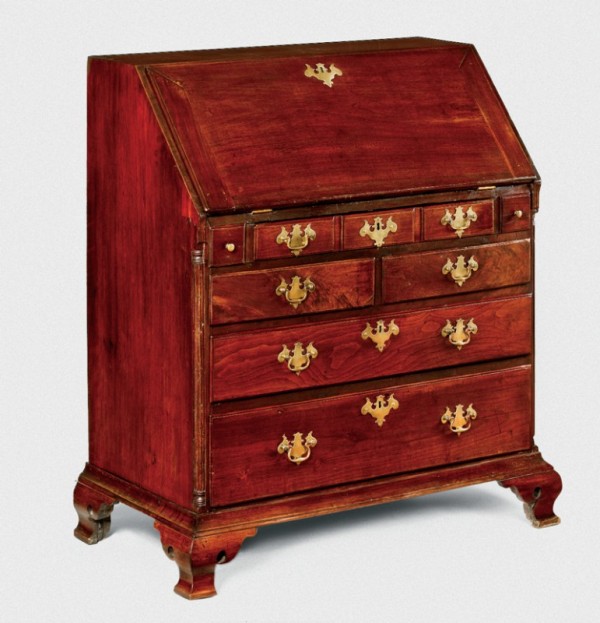
Desk, Nottingham area, Chester County, Pennsylvania, or Cecil County, Maryland, 1770–1800. Walnut with oak, chestnut, and tulip poplar. H. 45 1/2", W. 42", D. 22 1/2". (Private collection; photo, Gavin Ashworth.)
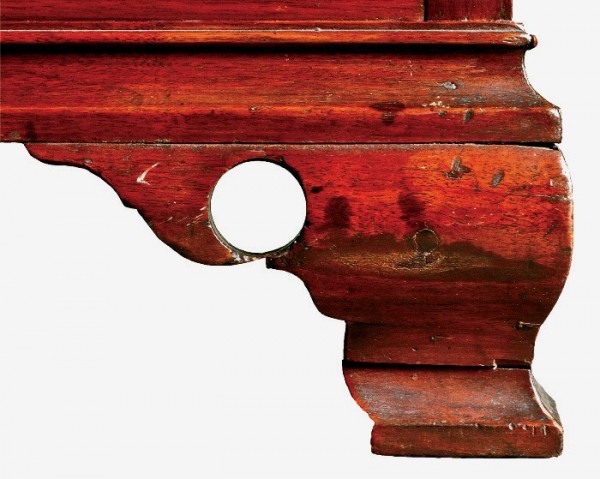
Detail of the right front foot of the desk illustrated in fig. 36. (Photo, Gavin Ashworth.)
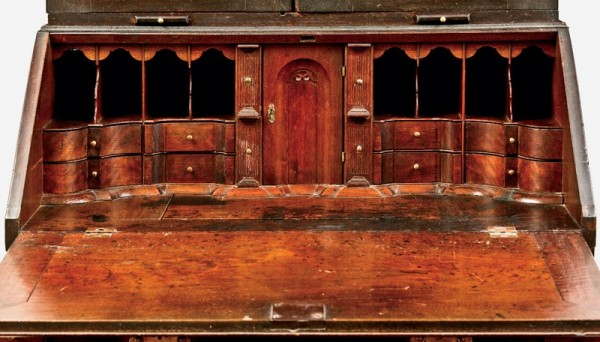
Detail of the interior of the desk-and-bookcase illustrated in fig. 33. (Photo, Gavin Ashworth.)
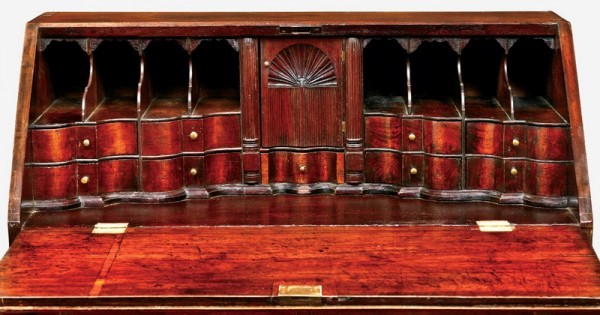
Detail of the prospect door and document drawers in the writing compartment of the desk illustrated in fig. 37. (Photo, Gavin Ashworth.) The carving on the prospect door is stylistically related to that on the ornament of the Coudon desk (fig. 33). Most desks from the Nottingham area have document drawers with fluted faces.

Desk-and-bookcase, Lancaster, Pennsylvania, 1770–1790. Walnut with tulip poplar and white pine. H. 102 3/4$", W. 37", D. 24". (Courtesy, Sumpter Priddy Antiques.)
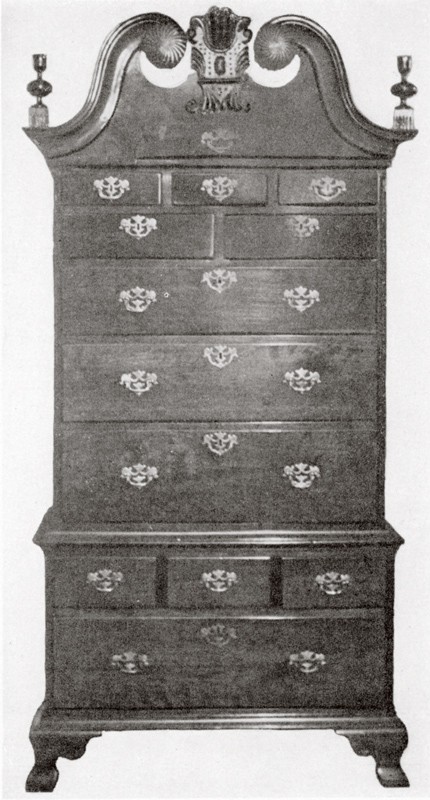
Chest-on-chest, Nottingham area, Chester County, Pennsylvania, or Cecil County, Maryland, 1760–1780. (Antiques 41, no. 1 [January 1942]: 8.) The cartouche on this example is similar to that on the Coudon desk-and-bookcase, with the exception of having gouge work on the flat surfaces around the cabachon.
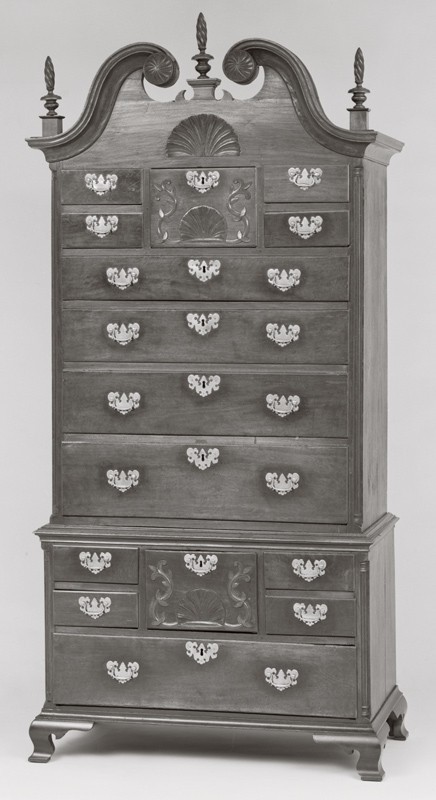
Chest-on-chest, Nottingham area, Chester County, Pennsylvania, or Cecil County, Maryland, 1760–1790. Walnut with white oak and tulip poplar. H. 90 1/2", W. 43", D. 22 3/4". (Courtesy, Yale University Art Gallery.) The feet and base moldings are integral.
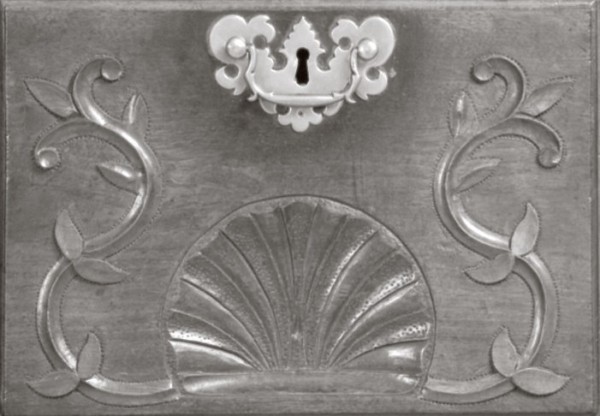
Detail of the upper carved drawer of the chest-on-chest illustrated in fig. 43. No other work by this carver has been identified.

Chest-on-chest with carving attributed to Nicholas Bernard, Philadelphia, Pennsylvania, 1770–1800. Mahogany with tulip poplar, yellow pine, and white cedar. H. 97", W. 42 1/2", D. 24". (Courtesy, Historical Society of Dauphin County, Harrisburg, Pa.; photo, Gavin Ashworth.)
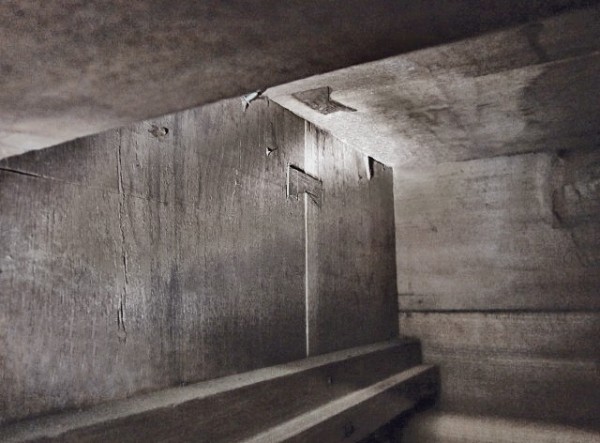
Detail of a Dutchman on the chest-on-chest illustrated in fig. 43. Dovetail layout lines scribed across the Dutchman prove those components were part the original construction.
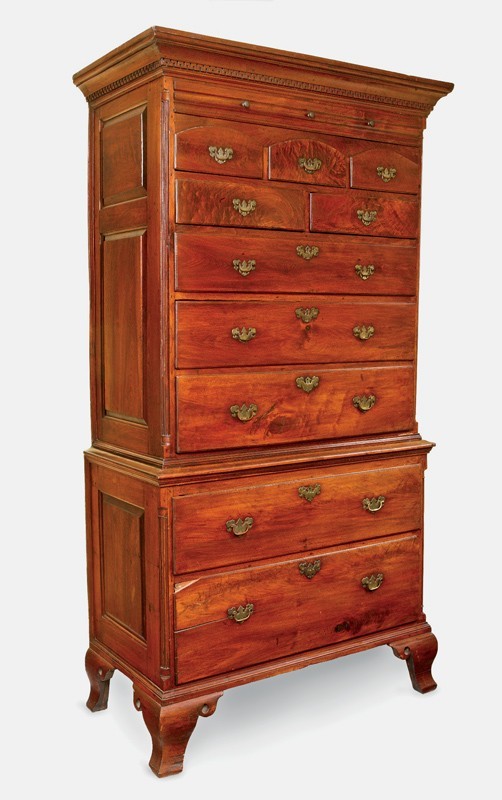
Chest-on-chest, Nottingham area, Chester County, Pennsylvania, or Cecil County, Maryland, 1770–1800. Walnut with oak and tulip poplar. H. 87 3/4", W. 46 1/8", D. 24 3/4". (Private collection; photo, Gavin Ashworth.) This chest-on-chest and the chest illustrated in fig. 48 are made of water mill–sawn boards just over one inch in thickness. The oak backboards of the chest-on-chest are original, but extraneous nail holes and remnants of plaster suggest they are reused architectural components. The sides of the chest-on-chest are paneled, a feature occurring on other case pieces from the Nottingham area. The molding on the face of the thin upper drawer differs from that of the example illustrated in fig. 48. Chests with an upper row of three arches are relatively common in Chester County, particularly the areas around New Garden, London Grove, West Fallowfield, and West Marlborough Township.
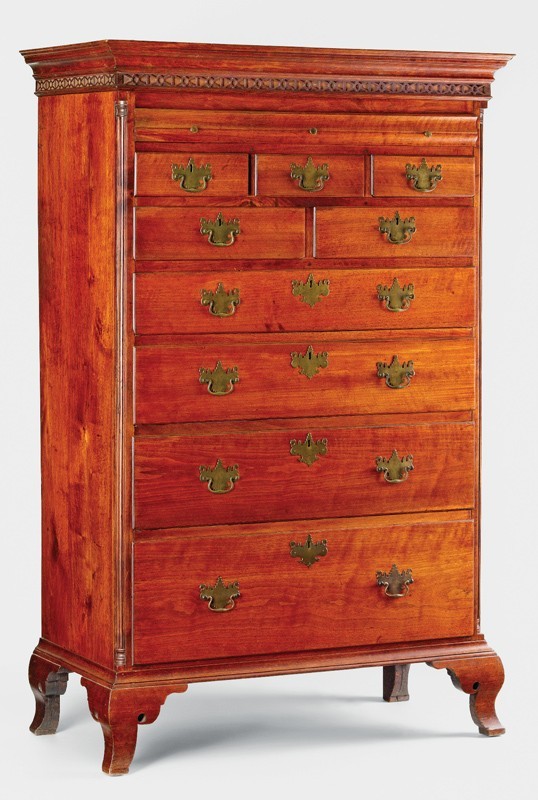
Tall chest of drawers, Nottingham area, Chester County, Pennsylvania, or Cecil County, Maryland, 1770–1800. Walnut with tulip poplar. H. 69 1/4", W. 44", D. 23". (Private collection; photo, Gavin Ashworth.) The cornice fret is similar to those on tall-clock cases from the Nottingham area.
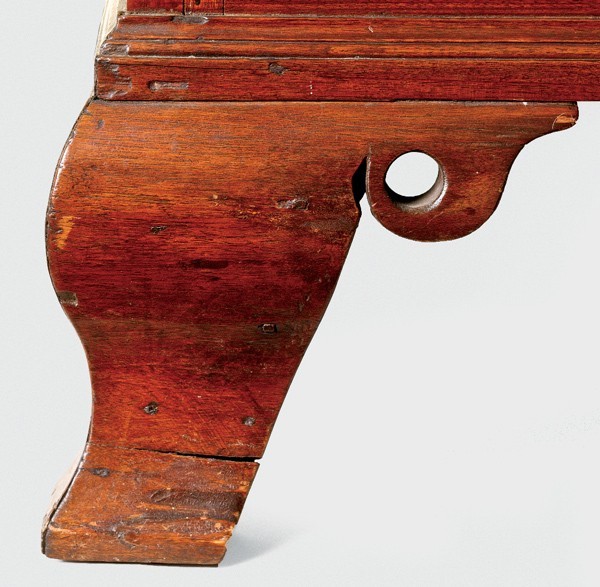
Detail of the left front foot and base molding of the chest-on-chest illustrated in fig. 47. (Photo, Gavin Ashworth.) The feet and base moldings are integral.
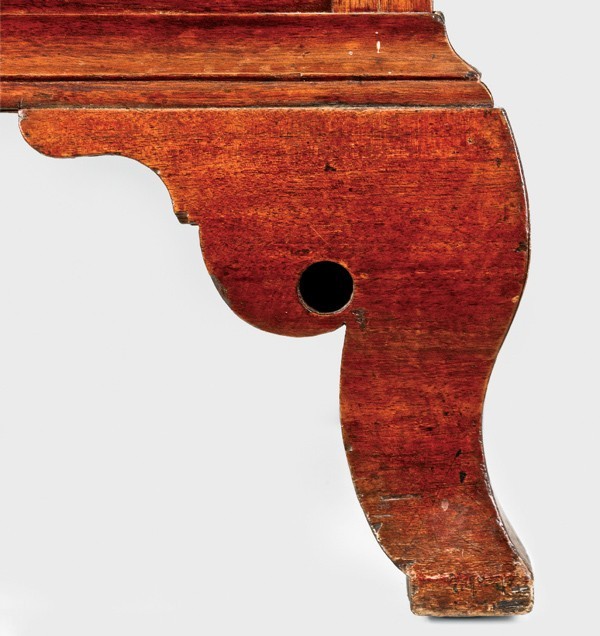
Detail of the right front foot and base molding of the tall chest of drawers illustrated in fig. 48. (Photo, Gavin Ashworth.) The feet and base moldings are integral.
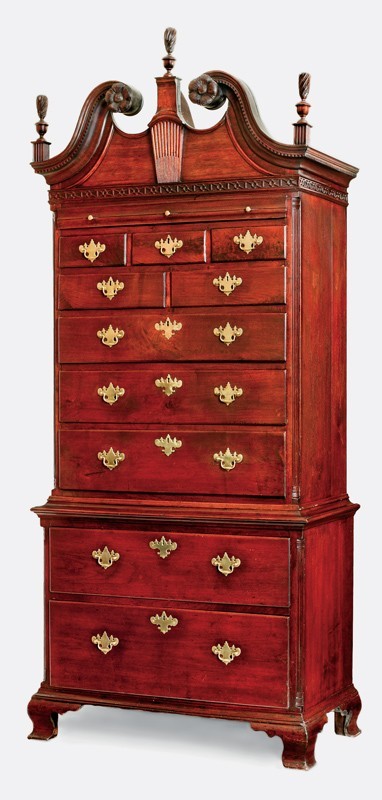
Chest-on-chest, Nottingham area, Chester County, Pennsylvania, or Cecil County, Maryland, 1780–1800. Walnut with tulip poplar and white oak. H. 100 1/2", W. 43 1/2", D. 23 1/4". (Private collection; photo, Gavin Ashworth.) The backboards of the pediment are joined with Dutchmen like the side and top boards of the chest-on-chest illustrated in figs. 43, 44, and 46.
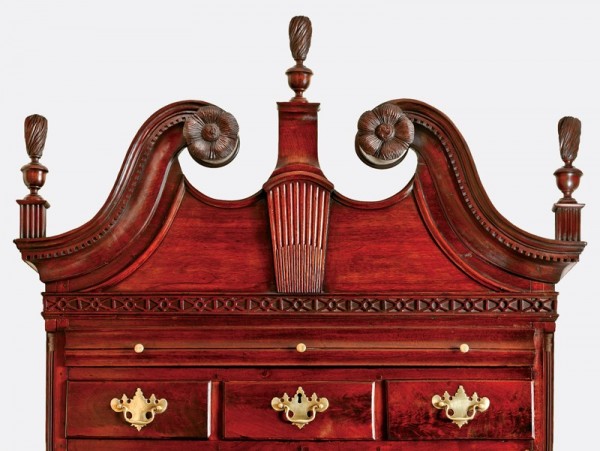
Detail of the pediment of the chest-on-chest illustrated in fig. 51. (Photo, Gavin Ashworth.)

Tall-case clock with movement by Benjamin Chandlee Jr., Nottingham area, Chester County, Pennsylvania, or Cecil County, Maryland, 1765–1790. Walnut with tulip poplar and yellow pine. H. 96 1/8", W. 21 1/2", D. 10 3/4". (Private collection; photo, Gavin Ashworth.)
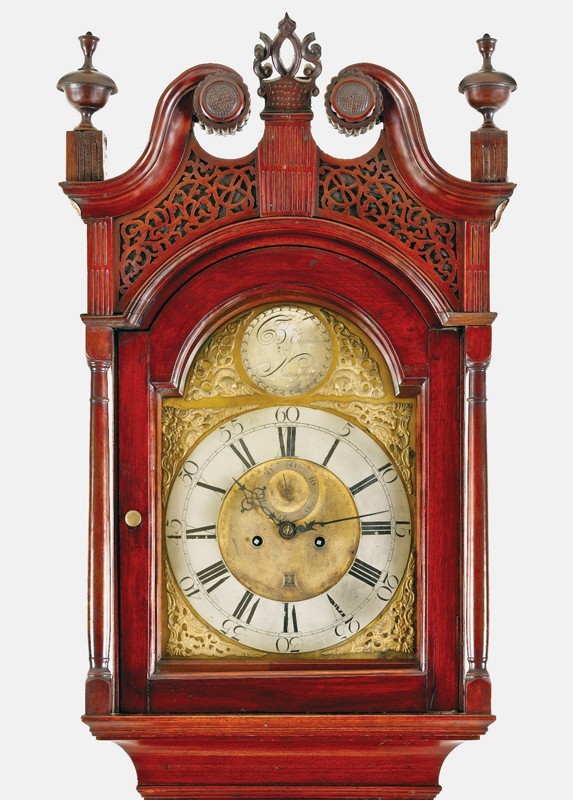
Detail of the hood of the tall-case clock illustrated in fig. 53. (Photo, Gavin Ashworth.)

Tall-case clock with movement by Benjamin Chandlee Jr., and case by Jacob Brown, Nottingham area, Cecil County, Maryland, 1788. Walnut with tulip poplar and hard pine. H. 107 1/2", W. 25 1/2", D. 14 1/2". (Private collection; photo, Laszlo Bodo.) The sides of the plinth extend to the floor to support the case and feet, which are integral with the base molding.
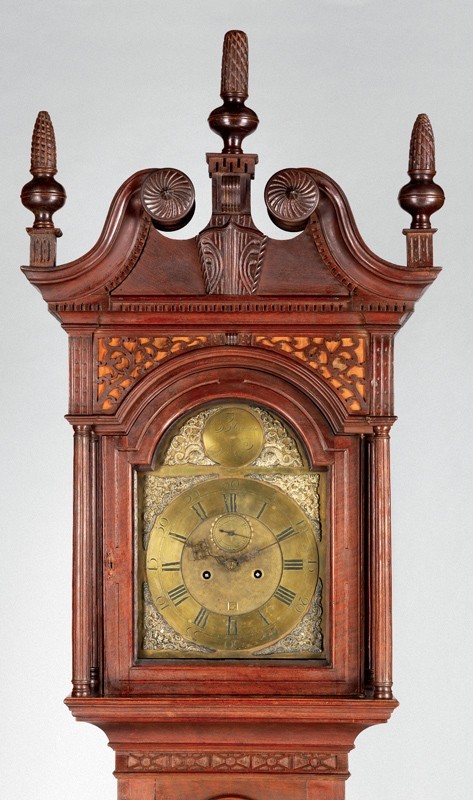
Detail of the hood and movement of the tall-case clock illustrated in fig. 55. (Photo, Laszlo Bodo.) The rosettes, which are similar to those on other locally made pieces, have stippling in the concave areas. The latter technique is repeated on the drawer shells of the chest-on-chest illustrated in figs. 43 and 44. Although the fabric behind the spandrel fret is replaced, evidence of the original textile survives.
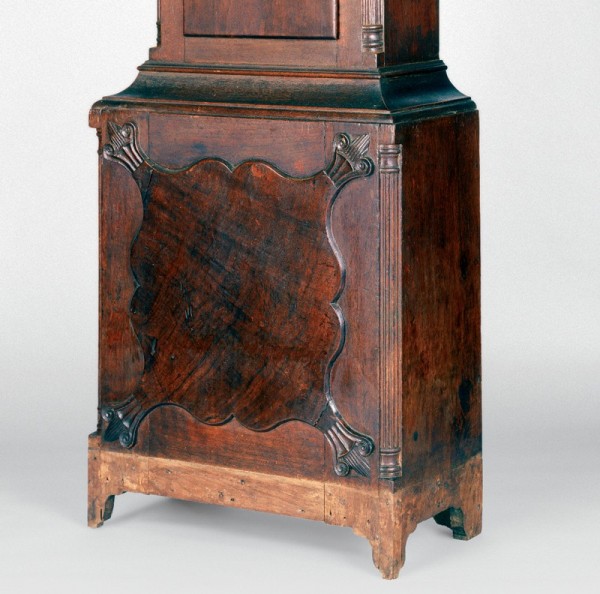
Detail of the plinth of the tall-case clock illustrated in fig. 55. (Photo, Laszlo Bodo.)

Tall-case clock with movement by Benjamin Chandlee Jr., case attributed to Jacob Brown, Nottingham area, Cecil County, Maryland, 1780–1802. Walnut with tulip poplar. H. 99 3/8", W. 22 1/4", D. 12 3/8". (Private collection; photo, Gavin Ashworth.) Details shared by this clock case and the McDowell example (figs. 55 and 56) include spiral rosettes, a corbel on the plinth of the tympanum, drilled dentil molding, and gouge-carved plaques above the colonnettes.
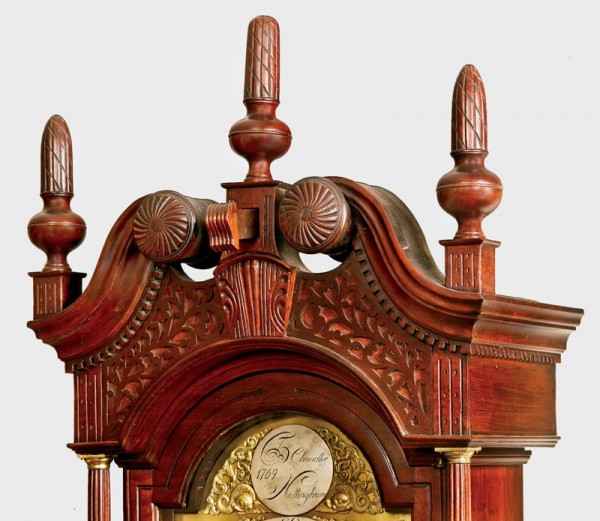
Detail of the hood, movement, and secret drawer of the tall-case clock illustrated in fig. 58. (Private collection; photo, Gavin Ashworth.) No other American clock with a secret drawer is known.

Tall-case clock with movement by Ellis Chandlee (1755–1816), case attributed Jacob Brown (d. 1802) or William Brown (d. 182?), Cecil County, Maryland, 1800–1815. Walnut with tulip poplar. H. 94", W. 21", D. 11". (Private collection; photo, Philip Bradley Antiques.)
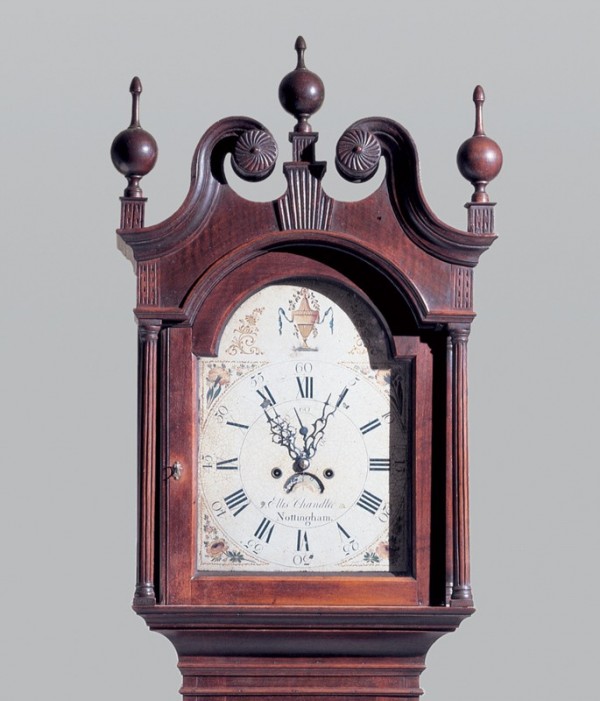
Detail of the hood and movement of the tall-case clock illustrated in fig. 60.
